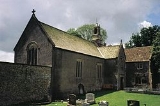
Church of the Holy Trinity, Bruton
Encyclopedia
The Church of the Holy Trinity in Wyke Champflower, Bruton
, Somerset
, England dates from 1623 and has been designated as a Grade I listed building.
A wooden tympanum between the nave
and chancel
bears the 1624 Royal Arms, the arms of the then Bishop of Bath and Wells
and the Archbishop of Canterbury
. The pews are Jacobean
pews and the large stone pulpit
Elizabethan
. The font
cover is from a similar era.
The church contains a black and white marble monument commemorating Henry Southworth, who was the Lord of the Manor
of Wyke, who died in 1625 and funded the construction of the church.
The parish is part of the benefice
of Bruton and District which falls within the Bruton and Cary deanery.
Bruton
Bruton is a town and civil parish in Somerset, England, situated on the River Brue seven miles south-east of Shepton Mallet, just south of Snakelake Hill and Coombe Hill, ten miles north-west of Gillingham and twelve miles south-west of Frome in the South Somerset district. The town has a...
, Somerset
Somerset
The ceremonial and non-metropolitan county of Somerset in South West England borders Bristol and Gloucestershire to the north, Wiltshire to the east, Dorset to the south-east, and Devon to the south-west. It is partly bounded to the north and west by the Bristol Channel and the estuary of the...
, England dates from 1623 and has been designated as a Grade I listed building.
A wooden tympanum between the nave
Nave
In Romanesque and Gothic Christian abbey, cathedral basilica and church architecture, the nave is the central approach to the high altar, the main body of the church. "Nave" was probably suggested by the keel shape of its vaulting...
and chancel
Chancel
In church architecture, the chancel is the space around the altar in the sanctuary at the liturgical east end of a traditional Christian church building...
bears the 1624 Royal Arms, the arms of the then Bishop of Bath and Wells
Bishop of Bath and Wells
The Bishop of Bath and Wells heads the Church of England Diocese of Bath and Wells in the Province of Canterbury in England.The present diocese covers the vast majority of the county of Somerset and a small area of Dorset. The Episcopal seat is located in the Cathedral Church of Saint Andrew in...
and the Archbishop of Canterbury
Archbishop of Canterbury
The Archbishop of Canterbury is the senior bishop and principal leader of the Church of England, the symbolic head of the worldwide Anglican Communion, and the diocesan bishop of the Diocese of Canterbury. In his role as head of the Anglican Communion, the archbishop leads the third largest group...
. The pews are Jacobean
Jacobean architecture
The Jacobean style is the second phase of Renaissance architecture in England, following the Elizabethan style. It is named after King James I of England, with whose reign it is associated.-Characteristics:...
pews and the large stone pulpit
Pulpit
Pulpit is a speakers' stand in a church. In many Christian churches, there are two speakers' stands at the front of the church. Typically, the one on the left is called the pulpit...
Elizabethan
Elizabethan architecture
Elizabethan architecture is the term given to early Renaissance architecture in England, during the reign of Queen Elizabeth I. Historically, the period corresponds to the Cinquecento in Italy, the Early Renaissance in France, and the Plateresque style in Spain...
. The font
Baptismal font
A baptismal font is an article of church furniture or a fixture used for the baptism of children and adults.-Aspersion and affusion fonts:...
cover is from a similar era.
The church contains a black and white marble monument commemorating Henry Southworth, who was the Lord of the Manor
Lord of the Manor
The Lordship of a Manor is recognised today in England and Wales as a form of property and one of three elements of a manor that may exist separately or be combined and may be held in moieties...
of Wyke, who died in 1625 and funded the construction of the church.
The parish is part of the benefice
Benefice
A benefice is a reward received in exchange for services rendered and as a retainer for future services. The term is now almost obsolete.-Church of England:...
of Bruton and District which falls within the Bruton and Cary deanery.

